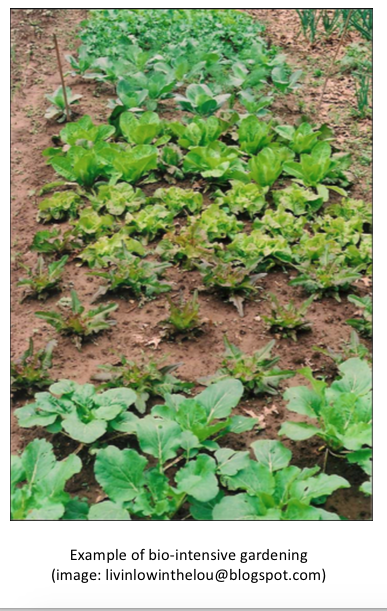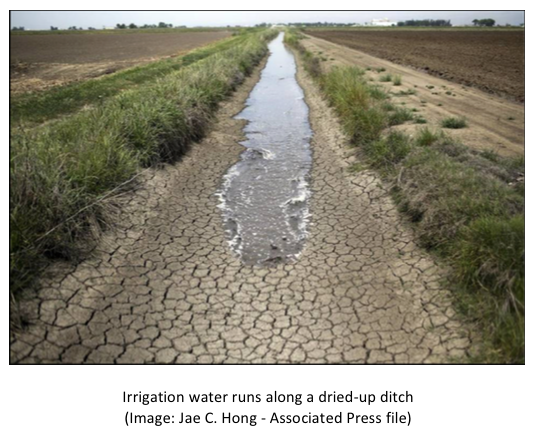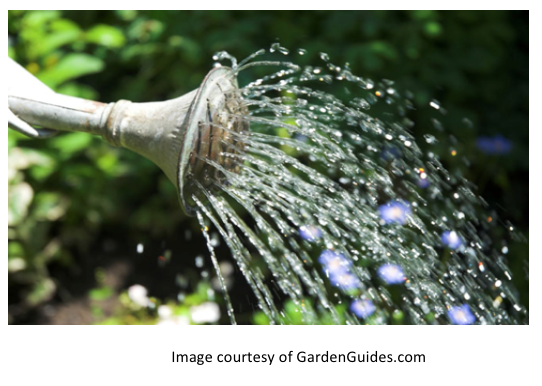Recently, a friend forwarded me a New York Times article about the nationwide use of California water through the consumption of food produced in the Golden State. The article, based on data from the University of California at Davis and the Pacific Institute, states that the average U.S. resident uses 300 gallons of California water this way, every week.
In the face of the worst drought in California recorded history, my inclination has been to stop growing water-thirsty annuals of any kind, including fruits and vegetables. Yet the Times article gave me pause; I feel confident that I can grow an asparagus tip using less than their stated .22 gallons of water and I most assuredly can grow an onion slice using less than .7 gallons!
Gardeners far wiser than I figured this out a long time ago. The phenomenal Rosalind Creasy - long a proponent of sustainable gardening - wrote a 2014 post on just this topic: “When in Drought – Plant Vegetables”. In her post, Rosalind states that growing the average pound of lettuce commercially uses 15 gallons of water, a pound of tomatoes 22 gallons, and a pound of potatoes 30 gallons. Bio-intensive gardener John Jeavons, Director of Ecology Action and author of the best-selling How to Grow More Vegetables, has demonstrated through years of hands-on research, that organic home gardening uses up to 87% less water to grow vegetables as compared to commercial farming. Contra Costa Master Gardener and journalist Joan Morris offers these additional tips for growing vegetables in a drought: 
- Don't spare the compost. Add 3 to 4 inches of compost to your garden beds and work it lightly into the soil. Healthy soil produces healthy plants, which need less water.
- Mulch. Add 3 to 5 inches of mulch on top of beds to help reduce water evaporation. Mulch can be almost anything including dried leaves, aged horse manure, extra compost or straw, not hay. Mulch also will repress weed growth.
- Install a drip irrigation system. Drip systems use much less water than any other form of irrigation, and the plants like it better, too.
- Be selective. Plant only what you like and only as much as you'll consume.
- Consider planting early maturing and short-season crops, which will use less water.
- Plant seedlings close together on an offset pattern, rather than in a row. This configuration uses less water and as the plants grow, they will shade the soil and reduce evaporation.
- Grow high-yield vegetables, such as beans, squash, egg plant, peppers and tomatoes. You'll get more for your water buck with these plants.
- Keep your beds weeded. Weeds not only are annoying, they compete with your plants for water and nutrients, and they are much better at grabbing them.
- When given a choice, plant determinate varieties. Determinate plants grow to a certain size and produce for a specific amount of time. Indeterminate varieties will continue to grow and produce until frost. The determinate types, with their shorter growing season, will use less water.
- Instead of planting seeds and watering the entire bed, start seeds in a tray and then transplant the seedlings into your garden.
- We typically do this with certain plants, such as tomatoes, in order to get a head start on the growing season, but consider doing it with the big seed plants such as pumpkins, corn and squash.
- Use shade cloth to help prevent soil evaporation and prevent sunburn.
- Try dry farming. Many plants, including tomatoes, can be dry farmed. Our Garden will have two demonstration beds this year, growing a number of different tomato varieties.
- For successful dry farming, you want to create a spongy growing medium that will hold water. The best way, Miller says, is to grow a cover crop over the winter and then cut the plants down and work them into the soil.
- If you didn't have a cover crop, then prepare the bed with lots of compost.
- Plant your tomatoes and water them as usual for the first few days to get them established, then water only once a week. Once the tomatoes flower and set fruit, cut off all water. The plants may not look great, but they will produce and some say the fruit will taste better.
So step aside, all you salvias and succulents – my vegetable garden is coming through! My rudimentary rainwater and graywater systems will do their best to keep those veggies hydrated, lots of nutrient-rich compost and a deep layer of mulch will keep them cool and moist, and long, deep sips from a drip irrigation system will fill in as needed.
Happy Gardening!
For additional information on dry farming tomatoes, see http://ccmg.ucanr.edu/files/140321.pdf

